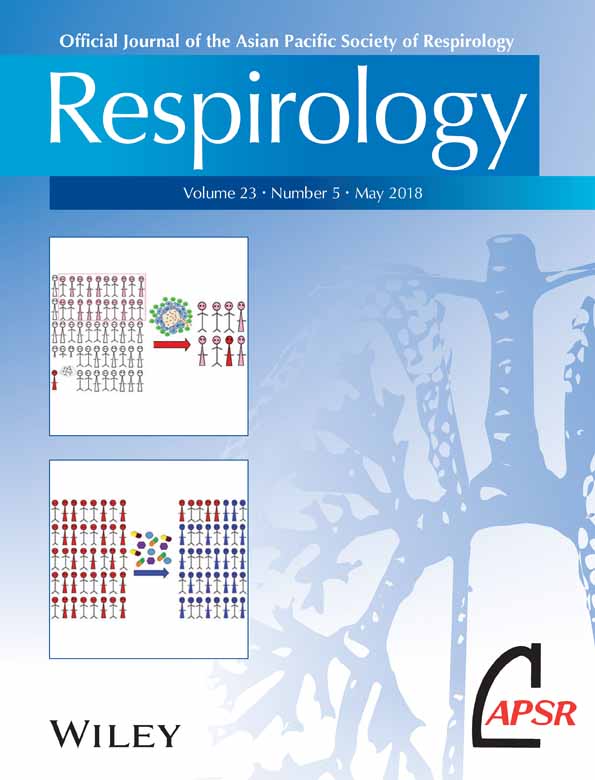Corticosteroids in acute exacerbations of idiopathic interstitial pneumonias: Time to debate – Reply
Abstract
See Letter
We appreciate Dr Sellarés et al.’s comments on our study investigating the efficacy of high-dose prednisolone after intravenous methylprednisolone in treating acute exacerbations (AE) of idiopathic interstitial pneumonias (IIP).1
We agree that ‘it is time to debate about corticosteroids in AE of idiopathic pulmonary fibrosis (IPF) (AE-IPF)’. We believe that our results may stimulate debate regarding the treatment of AE-IPF. Treatment with corticosteroids is not recommended in stable IPF, based on the results of PANTHER study2; however, treatment with corticosteroids remains controversial in AE-IPF.3 The Japanese diagnostic criteria for AE-IPF include progressive hypoxaemia4; therefore, we suppose that AE-IPF have been empirically treated with corticosteroids without definitive evidence. We could not directly compare survival of AE-IPF treated with and without prednisolone, so we compared the prognostic significance of high- and low-dose prednisolone therapy using multivariate analysis.
Subjects of our study had AE-IPF (n = 63) and AE-non-IPF (n = 22), including nonspecific interstitial pneumonia (n = 1) and unclassifiable IIP without surgical lung biopsy examination (n = 21). We evaluated the effect of prednisolone dose (high dose: ≥0.6 mg/kg, low dose: <0.6 mg/kg) in all AE-IIP patients because the survival and clinical demographics of AE-IPF and AE-non-IPF were similar. Prognosis of AE-IIP managed with positive pressure ventilation (PPV) was dramatically worse than that of AE-IIP without PPV. We showed a significant survival benefit of high-dose prednisolone for AE-IIP managed without PPV using multivariate analysis; however, high-dose prednisolone did not improve survival in AE-IIP with PPV.
Dr Sellarés et al. suggested that it was preferable to examine only the AE-IPF patients, as non-IPF patients may reflect a heterogeneous population, thus the effect of high-dose prednisolone on AE-IIP may be confounded. We have separately re-evaluated the effect of high-dose prednisolone on AE-IPF (n = 37) and AE-non-IPF (n = 13) without PPV. High-dose prednisolone was a significant predictor of good prognosis of AE-IPF without PPV (Table 1). However, high-dose prednisolone did not significantly affect prognosis of AE-non-IPF without PPV (P = 0.491, log-rank test). As Dr Sellarés et al. have also pointed out, the cumulative dose of corticosteroids might be associated with survival of AE-IIP. However, cumulative dose itself depends on the survival period, thus it may be difficult to examine this association.
| Parameters | HR | 95% CI | P-value |
|---|---|---|---|
| LTOT before AE, Yes | 2.158 | 1.06–4.393 | 0.034 |
| IgG × 100 mg/dL | 0.923 | 0.874–0.976 | 0.005 |
| Prednisolone dose, ≥0.6 mg/kg | 0.429 | 0.204–0.902 | 0.026 |
- Poor prognostic factors for AE-IPF managed without PPV (n = 37) were evaluated by multivariate Cox proportional hazard regression analysis with stepwise method using age, gender, smoking status, prednisolone before AE, LTOT before AE, PaO2/FiO2 ratio, IgG × 100, KL-6, SP-D and HRCT pattern (diffuse/non-diffuse).
- AE, acute exacerbation; FiO2, fraction of inspiratory oxygen; HR, hazard ratio; IPF, idiopathic pulmonary fibrosis; KL-6, Krevs von den Lungen-6; LTOT, long-term oxygen therapy; PaO2, partial pressure of oxygen in arterial blood; PPV, positive pressure ventilation; SP-D, surfactant protein-D.
In contrast, Papiris et al. treated AE-IPF according to their protocol consisting of immediate cessation of immunosuppression (if any), best supportive care and broad spectrum antimicrobials, and showed that survival of AE-IPF never treated with corticosteroids (n = 12) was better than if treated with corticosteroids before the onset of AE (n = 12).5 However, in their study, three patients with AE-IPF and multiple events were included as 10 separate patients of AE-IPF. Furthermore, there was no significant difference in survival from the onset of the first event of AE between AE-IPF patients who had not (n = 6) and had (n = 11) been treated with corticosteroids (P = 0.640).5
Our recommendation to treat AE-IIP with high-dose prednisolone is provisional because our study was retrospective with a limited number of patients. Our results should be confirmed in prospective randomized controlled trials.




